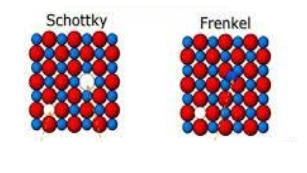Answer
424.5k+ views
Hint: AgCl is a chemical compound known as silver chloride. It is very less soluble in water. Each silver ion in the lattice’s interior binds with six chloride ions, and each chloride ion in the interior binds with six silver ions. Those ions on the lattice’s surface or edges bind to fewer than six ions and carry a partial charge.
Complete step by step answer:
-The two types of defects in any lattice structure are: Schottky defect and Frenkel defect. Schottky defect arises when equal numbers of cations and anions are missing from the lattice. It is a common defect in ionic compounds with high coordination numbers where both cations and anions are of the same size. Due to this, the density of the crystal decreases and it starts to conduct electricity to a smaller extent.
-On the other hand, Frenkel defect arises when some of the ions of the lattice occupy interstitial sites leaving the previous spaces vacant. This defect is found in ionic compounds in which the anion is much larger than the cation in size. The density of the compound does not change due to this defect and the overall composition remains the same.
-In AgCl, as the anion is much larger than the cation, it shows Frenkel defect. The silver ions are much smaller than the chloride ions. So, the silver ions occupy the interstitial sites, leaving a corresponding number of normal lattice sites vacant.

Hence, the correct answer is Frenkel defect.
Note:
Remember that the Frenkel defect does not change the composition of the compound as no ions leave the lattice in this defect. However, in Schottky defect, equal numbers of cations and anions leave the lattice.
Complete step by step answer:
-The two types of defects in any lattice structure are: Schottky defect and Frenkel defect. Schottky defect arises when equal numbers of cations and anions are missing from the lattice. It is a common defect in ionic compounds with high coordination numbers where both cations and anions are of the same size. Due to this, the density of the crystal decreases and it starts to conduct electricity to a smaller extent.
-On the other hand, Frenkel defect arises when some of the ions of the lattice occupy interstitial sites leaving the previous spaces vacant. This defect is found in ionic compounds in which the anion is much larger than the cation in size. The density of the compound does not change due to this defect and the overall composition remains the same.
-In AgCl, as the anion is much larger than the cation, it shows Frenkel defect. The silver ions are much smaller than the chloride ions. So, the silver ions occupy the interstitial sites, leaving a corresponding number of normal lattice sites vacant.

Hence, the correct answer is Frenkel defect.
Note:
Remember that the Frenkel defect does not change the composition of the compound as no ions leave the lattice in this defect. However, in Schottky defect, equal numbers of cations and anions leave the lattice.
Recently Updated Pages
How many sigma and pi bonds are present in HCequiv class 11 chemistry CBSE

Why Are Noble Gases NonReactive class 11 chemistry CBSE

Let X and Y be the sets of all positive divisors of class 11 maths CBSE

Let x and y be 2 real numbers which satisfy the equations class 11 maths CBSE

Let x 4log 2sqrt 9k 1 + 7 and y dfrac132log 2sqrt5 class 11 maths CBSE

Let x22ax+b20 and x22bx+a20 be two equations Then the class 11 maths CBSE

Trending doubts
Fill the blanks with the suitable prepositions 1 The class 9 english CBSE

At which age domestication of animals started A Neolithic class 11 social science CBSE

Which are the Top 10 Largest Countries of the World?

Give 10 examples for herbs , shrubs , climbers , creepers

Difference between Prokaryotic cell and Eukaryotic class 11 biology CBSE

Difference Between Plant Cell and Animal Cell

Write a letter to the principal requesting him to grant class 10 english CBSE

Change the following sentences into negative and interrogative class 10 english CBSE

Fill in the blanks A 1 lakh ten thousand B 1 million class 9 maths CBSE



